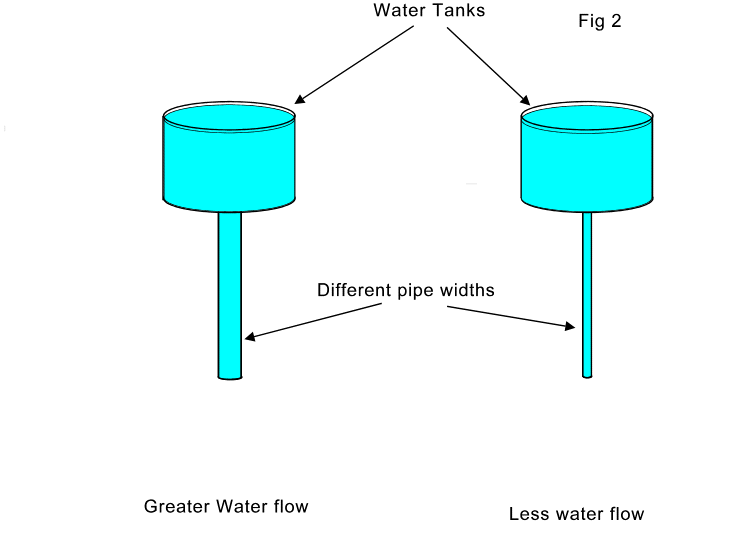
|
To help visualise electricity flowing through an electric circuit, consider how water flows through pipes in your home. The water is stored in a tank, normally in the loft space and feeds down through pipes to your bathroom, kitchen and other water outlets Increasing the pressure of the water in the pipe speeds up the flow of water from the outlets, see fig 1. One way to increase the water flow from the outlet tap is to increase the height where the the water tank feeding into the pipes is stored. Study the water flowing from the various taps in your house, for example look at the water flow from the hot tap in the upstairs bathroom of your home then look at the flow of water from a hot tap in the downstairs kitchen or bathroom, you will see a difference in the rate at which the water flows from both taps. The water flowing from the downstairs tap runs faster than that from the upstairs tap. This difference is caused by the pressure between the outlet at the lower level tap being greater than the pressure of the water fed to the upper level tap. This difference in pressure is caused by height difference between the taps and the water storage tank. The Greater the height between the outlet tap and the water source, the greater the water pressure and the
faster the water will flow from the outlet. |
 Fig 1 |
|
Tanks A and B above are identical,
Water always takes the easy route
| |
|
Fig 2 illustrates a situation where two identical water tanks have drain pipes fitted to their base,
Water will flow from both tanks and run out of the outlet pipes. The outlet pipe from the left hand tank is twice the diameter of the outlet pipe fitted to the tank on the right. This will allow approximately twice as much water to flow from the tank. By doubling the internal diameter of the pipe we have halved the resistance offered to the water escaping from the tank. This is true for electric current flowing through a conductive circuit. |
Fig 2 The flow of both water and electrons is controlled by the amount of resistance placed into the circuit or network.
|
| Electrons like water flow from a high pressure
to a low pressure. Water uses hollow pipes while electrons flow through solid conductors such as copper
wires. The flow of electrons is measured in amps.
The relationship between current flow pressure and resistance is extremely important and a grasp of this relationship is fundamental to understanding the actions of an electrical circuit.
Although this example deals with water flow, the same principles apply to electrical current flow where:
In an electrical circuit, the force of electron pressure is called a power source.The pressure applied by this power source is measured in volts.The input voltage may be supplied by a battery - power supply - some other form of generatorThese Voltage sources act like a water pump in a central heating system, where the pump remains in the one place but forces the water to flow through the network of pipes. The voltages source performs the same king of action by remaining in the one spot and forcing electron current to flow through the network of conductors. |
|